This guide is all about men’s wallets, billfolds or portemonnaie as some call them. In it, we’ll delve into various styles, how they’re made and what quality hallmarks you should look for along with some recommendations.
Wallet Guide Video
Despite living in a highly digitized world, old world items such as a tailored suit, a letterpress calling card, or a nice wallet have a huge impact on first impressions. A canvas wallet that is closed with velcro or a tattered old billfold can indicate that your style is only surface deep. It’s an object you use and reuse every day.
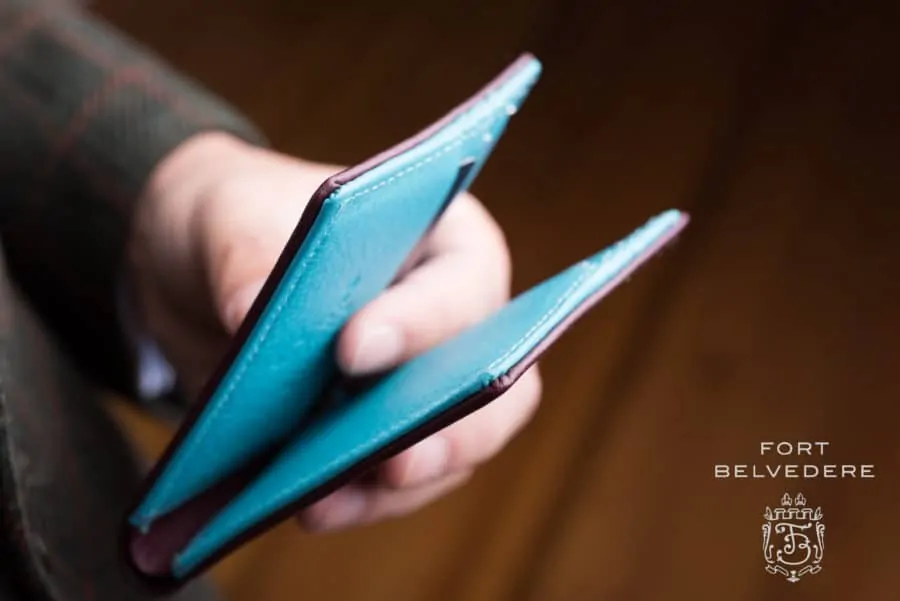
Just like the clothes you wear, your wallet should be an extension of your wardrobe, which serves as an advertisement for the type of person you are.

A Brief Wallet History
The first wallets – as we know them today – were created following the development of paper currency in America in 1690 when it was introduced by the Massachusetts Bay Colony.
Of course, wallets were around for centuries prior, dating back as far as Ancient Greece when gentlemen would carry a pack stocked with food and some survival equipment. Of course, their use has changed drastically, but that’s par for the course with many gentlemen’s accessories. What’s especially interesting to note, is that the wallet was initially for poor men who couldn’t afford a portable larder on their journeys.
As the use changed, coin purses were introduced, typically made from a leather pouch or sack that featured a drawstring to secure it. Then, following the use of paper currency, the modern version of the wallet began to appear.
Originally made from the hides of cows or horses, the early wallets were used for carrying currency, dried meat, valuables and visiting cards. By the 19th century, most men carried one, typically fastened to his belt as keeping it in a pocket was considered undignified. However, this was only common in some parts of the world. In other regions, such as Spain, the wallet was a carrying case for smokers. They would keep their flint and steel, rolling papers and yesca, which was used to ignite the rudimentary cigarette.
Today, wallets have become a common everyday carry accessory for both gentlemen and ladies. It is now used – almost exclusively – to carry currency, credit cards, and identification. Although it may seem as though the contemporary wallet has been around for centuries, the fact is that the pocket-sized wallet we use today was only developed in the early 1950s when the first credit cards were introduced.
Craftsmanship Hallmarks of Men’s Wallets
Like many items in a gentleman’s wardrobe, the wallet comes in a wide range of standards. There are canvas wallets with velcro closures that sell for a few dollars, and then there are quality wallets offered by heritage makers that are handcrafted from the finest leathers. These tend to sell for upwards of a few hundred dollars. To get the best wallet for your money, look for the following quality hallmarks:
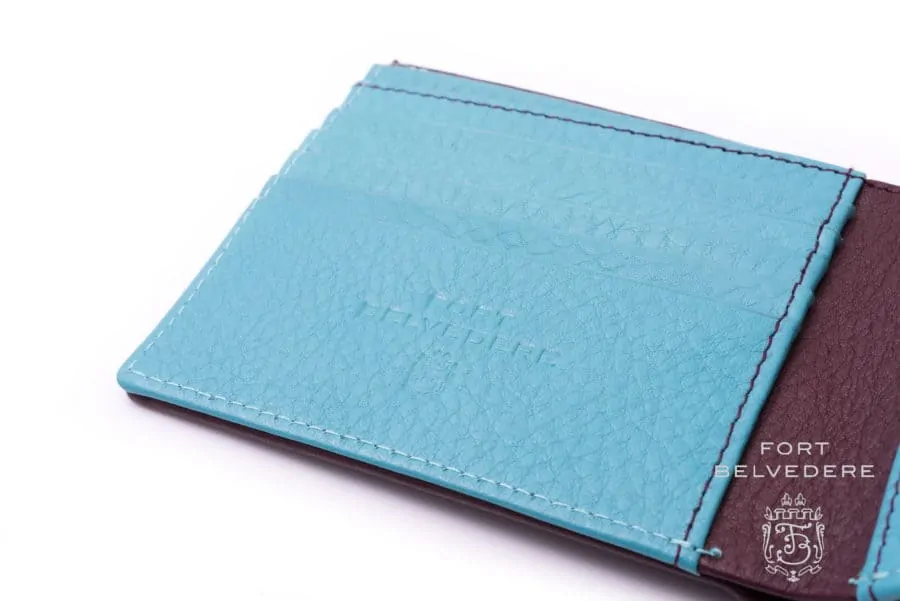
Thin, Open Pore Aniline-Dyed Leather: Most people don’t consider the type of leather used in their wallets, and one of the biggest mistakes made is assuming that just because the wallet is stamped “Genuine Leather”, that all leather is the same. That is simply untrue.
Begin by looking for leather that is aniline-dyed and not pigment-coated. That means that the surface has not been sanded or coated with a layer of paint. Instead, the supple surface that shows the characteristic pores of the leather should be visible.
Only 5% of the world’s leather is good enough to be used uncorrected, and it has a luxurious tactile feel that will develop a beautiful patina over time. Technically all full grain leathers should be uncorrected but today, many companies sell corrected leathers as full grain.
The remaining 95% of wallet leather needs a coating to counteract defects in the leather, either to even out the color or improve its durability. You can identify leather will look smoother, feel stiffer, and will not develop a patina, which means that the appearance will end up looking worn over time.

RECOMMENDED
Men’s Leather Wallet in Whisky Brown Boxcalf and Blue Deerskin with 10 Card Slots by Fort Belvedere
You can tell if a leather is pigment-coated by looking for pores; if you can see fine pores, the leather is likely not pigment coated. Sometimes the correction process includes an embossed leather pattern that looks like natural pores, so don’t be fooled! To see if a leather was coated or not, you can bend the leather back and forth to see what the leather looks like. Large scales and thick paint will become much more visible.
Unfortunately, many wallets today are made of pleather which is an artificial faux leather. They come in plain black or brown and are meant to be used for a year or two and then discarded when they look bad.
Finally, consider the type of leather. Unembossed boxcalf or deerskin is sturdy enough to produce a long-wearing wallet, whereas other leathers such as lamb and pigskin are too delicate to stand up to years of use.
For wallets, it is particularly important that the leather is not embossed because it is subject to constant bending at the corners and embossed leathers wrinkle a lot quicker than unembossed leathers.
Leather-Lined Divider: Another key indicator of a high-quality wallet is to look for wallets that exclusively use leather and don’t cut corners by using a less expensive fabric or poly-blend to create the divider or lining inside the wallet. A quick perusal of our recommended wallets below will reveal that very few wallet manufacturers show pictures of the interior of their wallets, and they only mention the material used on the exterior, so you may not know what the lining is made of before you buy.

Folded and Sewn Edges: Most wallets are made using single fold edges that are cut once folded. While functional, it is not the most elegant solution.
Higher-quality wallets will feature a double fold on the shell as well as the lining. As a consequence, the lining and the shell neatly go all the way to the edge. In order to achieve flat edges, the leather has to be thinned at both edges, before it is folded and. This higher end method of folding the lining and the shell is seen rarely because it requires more time than the regular fold and skilled craftsman.

Edge Painting: If the edges on a wallet are not folded, they must be edge painted in order not to be rough and scratchy. First, the leather is sealed with a hot iron called Filiteuse and wax. Subsequently, it is painted with two or three coats of paint. Although popular with belts, edge painting is rarely seen on wallets because it shows wear more easily, than a double or single folded edge.
Sewn Card Slots: There are three varieties of card slot design. The first cuts individual leather pieces, sews the edges, and then layers them into the shell of the wallet to form the card slots. Each slot is lined to help the card slide in and out easily, and the sewn edges help the leather resist stretching and retain its shape over time.

The second method cuts individual leather pieces, folds and glues the edges, and then layers then into the shell of the wallet. While better than the third method, it’s not as good as the second because glue is not as long-lasting or stretch resistant as sewn edges.
The third method cuts a single piece of leather and cuts slits for the cards to slide into. This method is a much simpler construction technique that reduces both the assembly time and quantity of leather needed for each wallet, which is cheaper for the manufacturer but rarely are those savings passed on in the final price. The cut card slots are narrower than in a sewn card slot and lack a liner, which makes it harder to get cards in and out in the beginning. Since the leather is cut, it will stretch and wear over time, so cards may fall out after a few years of use.
Rounded corners: Not only does this feature look more sophisticated, but it also helps to slow down the wear of the corners tremendously. Rounded corners help wallets slide in and out of pockets with less resistance.
A Point of Interest: Wallets can be so…boring. Basic black and brown wallets have made this an uninteresting accessory for years, but thankfully many companies are no longer happy to just produce forgettable wallets that only exist to serve a basic function. Details such as contrast stitching, contrasting interior colors, exotic leathers and monogramming all add interest
Durability: The biggest difference between wallets is how long they still look good – a year? a few years? An inexpensive wallet may last a few years and cost only a few dollars, but quality wallets have enduring value and will last a lifetime or more if well cared for. Almost all of the above quality hallmarks play a role in extending the life of your wallet, most especially in the choice of leather and the construction techniques.
No Plastic: While it may be convenient to not have to pull out one’s ID every time it’s needed, the plastic slot found in some wallets is simply not a feature you want in a wallet you’ll keep for years. Plastic doesn’t age well and it catches dirt, and it cheapens the overall look of any nice wallet. Just say no to plastic.
Initials: While not a hallmark of quality, it is a popular gift idea to add initials to a wallet. Blind embossing is more subtle and will look good over time, while gold or silver foil embossing stands out in the beginning but it shows wear after a few years. If you are not sure about initials just wait because you can always easily have them added after the fact but you cannot remove them.
Types of Wallets
There are many types of wallets on the market today. Here are a few of the most popular styles for dapper gentlemen.

Billfold with Coin Purse
A billfold is the traditional pocket wallet. It gets its name from the appearance of being closed, which causes any paper currency (or bills) to fold in half. Most of these wallets will feature three to eight credit card slots and two or three other pockets for identification or calling cards. Sometimes, they will feature a slide-out or third sleeve that allows more cards to be placed in the wallet. The right side – in most cases – of the interior, features a coin purse usually secured with a snap or a zipper. For men who carry change, such as anyone who uses the Euro as their currency, this can be useful. In countries in which the currency is less cash- and coin-dependent, a coin purse adds unnecessary weight and bulk.
Billfold with no Coin Purse
The most popular form of billfold, this is similar to the billfold mentioned above, except that instead of a coin purse it offers three or four more card slots for credit cards. When made well and not overstuffed, these billfolds can be slim enough for most pockets and look attractive. For most men who wear a selection of various styles of dress from casual wear to formal wear, this is the best style of an EDC wallet.

Minimalist Wallets
These are fairly new and gaining in popularity, since slim fit trousers or preference for carrying less cause men to seek out wallet alternatives. This wallet is typically a double sided sleeve that allows you to store a few cards, a piece of identification and well-folded paper currency. You can’t store as many items in it, but it is ideal for men who value less bulk over everything else. Another benefit to these wallets is you can often find an elegant and well-made wallet for less than you would in a billfold or coat wallet.

Coat Wallet
The coat wallet is ideal for men who regularly wear odd jackets, blazers, suits and formal wear. Unlike the billfold, this wallet is long and narrow like a check book. It is intended for being carried in the inside breast pocket of a jacket, rather than in your trousers. These wallets differ, some offering credit card slots on both sides, with others offering a spot for your check book or paper currency on one side, with credit card slots on the other. For men who carry multiple cards, these wallets are ideal as often they can hold upwards of 20 cards.

Phone Wallet
Another relatively new creation, the phone wallet is a case for your smartphone that is shaped like a wallet and opens the same as a billfold or coat wallet. On one side, it has a spot for your smartphone, and the other offers a few card slots, a spot for identification and a place for paper currency. Some even offer a spot for a pen or stylus in the crease.

Card Holder
For gentlemen who only carry a single credit card and perhaps a piece of ID, a calling card case can offer the dual ability to serve as a wallet. For example, the calling card cases from Fort Belvedere have two slots which can allow you to reserve one for currency, a credit card and a piece of ID. The other side can still be used to store your business cards.
Travel Wallet
A travel wallet comes in numerous shapes and sizes. Most of them are distinguished by their closing zipper or the ability to hold a passport. Unless you’re traveling, we don’t recommend this style for everyday carry.
Other Styles
There are numerous styles hitting the market all the time. From the traditional money clips to carbon fiber and other materials woven into wallets, the classic and refined approach is to stick with leather. You can always add RFID protective sleeves and some heritage makers do offer security options for those with concern.
What to Put in Your Wallet
The fact is, the wallet has gone from a place to store food and dried meats to a spot for the necessary cards and currency. Your wallet should contain anything you need to get through a typical day with ease. The last thing you want to do is overstuff your wallet which can cause it to break down and will ruin its shape.
Wallet Contents DOs and DON’Ts
- DO carry anything you need to conduct your day-to-day activities
- DON’T carry cards daily that you don’t use regularly. Go to Costco once a month? Bring it only when you need it or have a staff member look you up.
- DO clean your wallet out often to remove any unnecessary bulk, such as old receipts
- DON’T carry your business cards in your wallet. Nobody is impressed by a dog-eared business card. Get yourself a proper business card case instead.
- DON’T carry anything that can permanently stretch or distort your wallet such as anything thicker than a credit card or collar stays
Recommended Wallets

Ettinger
Ettinger had a global marketing push a few years back. Based in England, they have been handcrafting wallets for London’s aristocrats and members of nobility since 1934. They offer a wide range of wallets in different colors, often made to order.
Note that these wallets have edges that are folded, sewn and cut, so despite their bright interiors the color will not extend to the edge. Also, their divider is not made from the same contrasting leather as the other parts. The result is a less-rounded corner that appears to be a solid wallet from the exterior. If you can wait for it to be made, and you are fine with their cut edges, you may find a wallet you like.

Launer
Well regarded as the purse purveyor of Queen Elizabeth II, Launer offers a range of traditional pocket-sized billfold, as well as coat wallets. For gentlemen seeking a bold, yet elegant wallet, the contrasting color palettes from Launer are some of the most intrepid we’ve seen. Note that like the Ettinger wallets, these wallets have edges that are folded, sewn and cut at the edges and often have folded credit card slots.
Montblanc
Another well-known maker famous for their fine writing instruments and timepieces, Montblanc has been making leather goods for years. Initially made in Germany they moved their entire leather goods production to Italy. They like to use coated leathers in black but they also have uncoated ones. If black you like plain black and you don’t mind the obvious logo on the outside, here is a prime wallet from their Meisterstuck collection. or choose from one of their other black options.

Edward Green
You may have read our reviews of Edward Green shoes in the past. Like their footwear, their wallets are made using high quality leathers, handcrafted by artisans in their workshop. This one is constructed from genuine alligator skin and edge painting. If you have $915 to spare, this is wallet could be yours.
Fort Belvedere
As you can see, it is difficult to find a wallet that has it all at a price that isn’t astronomical. Therefore, Sven Raphael Schneider decided to create his own billfold wallets.
He tested prototypes in different leather combinations for three years to make sure the wallets hold up and look good. Lamb leather was super soft but wore out the quickest and looked terrible after a few weeks. The black long grain leather didn’t look the part because the embossed long grain resulted in wrinkles. Pig skin was a bit too soft, and suede lining was likewise to soft and not stiff enough. Saddle and bridle leather were too stiff in the pocket but boxcalf and deerskin held up extremely well, physically and optically.
Unlike most wallets that fit 6 or maybe 8 credit cards, this wallet fits 10. Nevertheless, it is a simple billfold without a third card holder layer, and comes with double folded edged, and a leather divider in the same quality leather you can see on the outside without being too thick.
As you can see it features all the hallmarks of a quality wallet and at $285 it costs just a fraction of the Edward Green wallet. Whether you look for a gift or you just want it for yourself, the black and red wallet is a timeless classic that will last for years to come. You will not find a higher quality wallet in that price range.
Also make sure to take a look at our wallet in Whisky Brown Boxcalf with Blue Deerskin Lining, and our cordovan oxblood deerskin billfold wallet with turquoise deerskin lining, or get all three of them of and match your wallet with your shoes or other leather accessories as your mood strikes.
Anson Calder
For a minimalist wallet that is just for the absolute essentials, consider the Anson Calder 1/8″ French Calfskin Wallet.

Edward Field
In case you want to combine your iPhone with your wallet, consider the Edward Field Classic Phone Wallet. Though untraditional in style, with few card slots, and only suited to an iPhone, this company uses a nice leather that ages beautifully.
Conclusion
We hope you’ve enjoyed this primer on wallets for the discerning gentleman. What wallet do you carry? Do you have any tips for buying a good quality wallet?


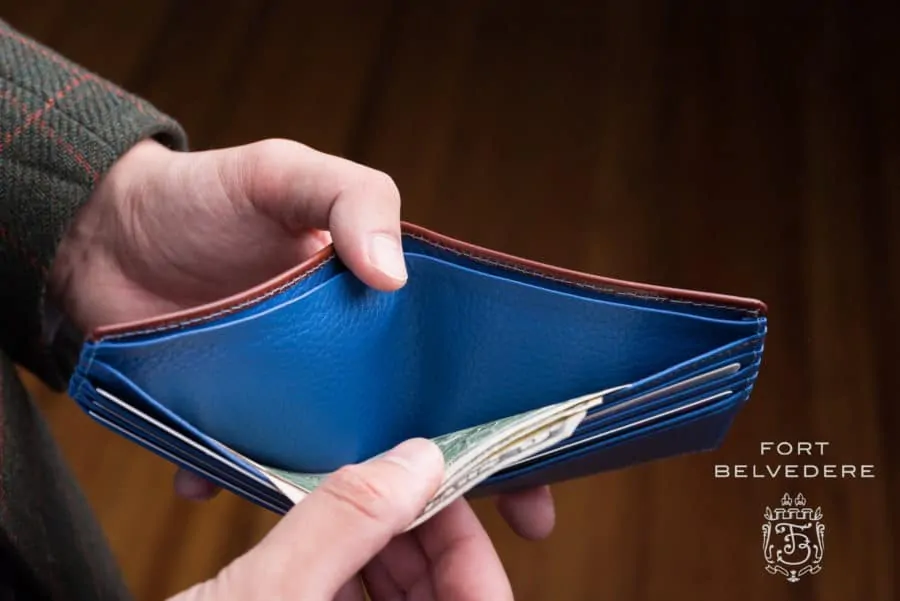
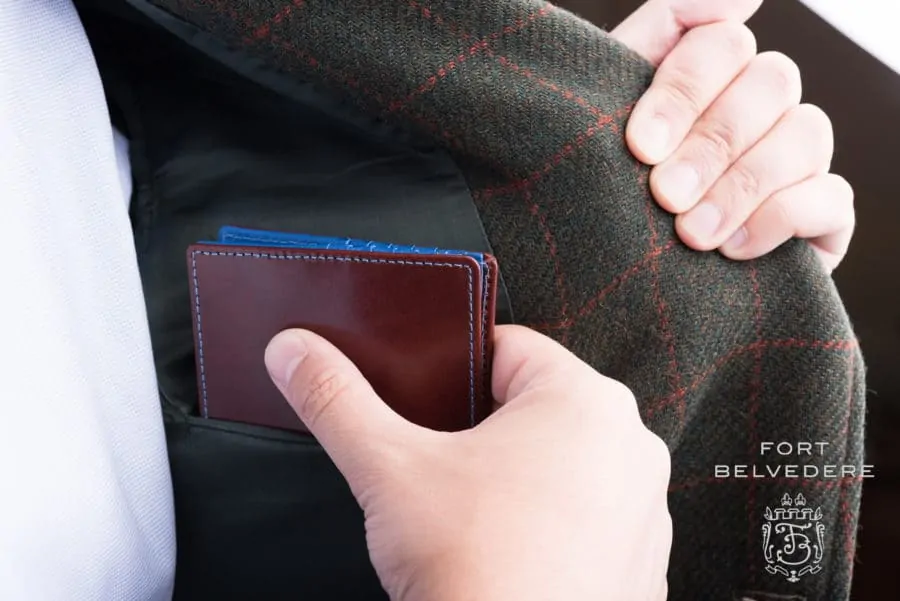



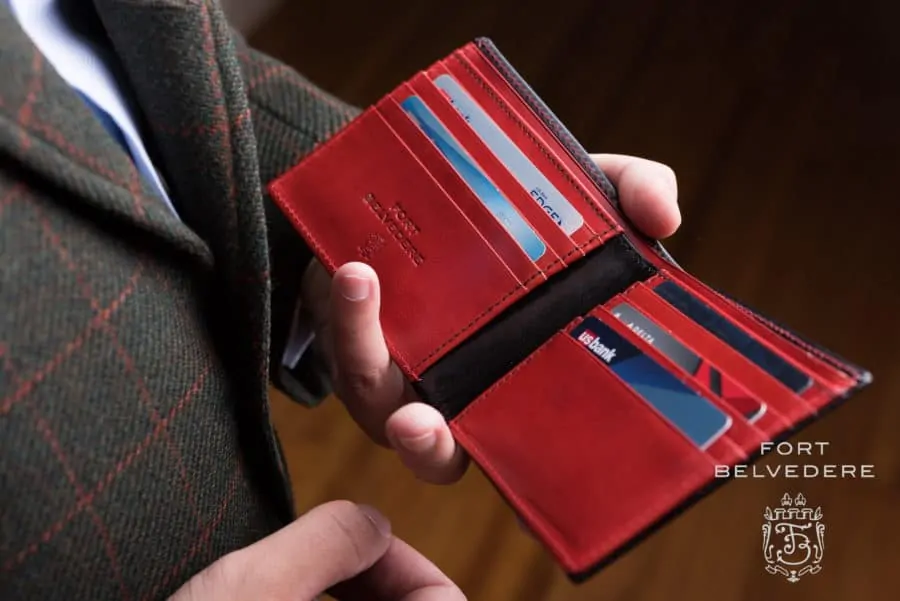


Crocodille wallet seems to be a very attractive form of the crocodilles social existence.
I had to go look at mine. It obviously misses several of the features you mentioned, but I was surprised at how many it possesses.
As my online persona suggests, before retiring, I was first a construction worker, then I owned a small construction company. I took to wearing Carhartt clothing most of the time and purchased a Carhartt billfold from them. It is extraordinarily rugged, though not terribly elegant. I believe it was under $50 but it has individual leather slots for cards. It also is folded once and stitched. Everything is stitched. It has added corner gussets with brass studs. Again, not nearly as elegant, but sturdy. Another interesting divergence is that it is fully lined with their signature brown canvas rather than leather. It is, however, fully lined. I have no idea what type of leather is used in the construction, but after many years of hard use, it looks… comfortable. Certainly not worn out and the leather has beautiful patina and layering.
Overall, a fascinating article. Once again, thank you for the information.
Ov
I checked further; I believe I can see the smooth, unpainted finish, and open pores in mine. They are known for quality, if nothing else. Style may be secondary, but it’ll last!
My only suggestion, based on my own personal experiences, is the Bottega Veneta wallet. I have had one for a decade and it continues to hold up to everything I throw at it and more: the leather has developed a beautiful patina, all of the stitching and edges look perfect, and I get many compliments on it; plus, since it is in their Intrecciato pattern, which is subtle but attractive. Anyways, that’s my only additional point on an excellent article.
I travel weekly and carry a Ghurka Passport No. 187 wallet. It’s slim enough and fits perfectly into the breast pocket of my tailored sport coats and blazers. I’d highly recommend it.
Thank you for the suggestion, Justin.
How many wallets should a gentleman own?
What occasion demands each of the wallets answered for the above question?
Where should a gentleman place each of the aforementioned wallets?
I’ve used the Moneyclip wallet from Mitchell Leather in Milwaukee for many years. It’s made of good quality leather, seems to be well-constructed, and has held up for a prolonged period. It’s very thin and light. It did take some getting used to using the money clip, but worked out very well after the initial learning curve. Pretty cost-effective as well. I spoke with Dave Mitchell, the owner, very nice and informative man. Worth looking at
We appreciate your comment. Thanks!